ENGL101 Essay: How TV Media Portrays Indigenous People Analysis
VerifiedAdded on 2023/05/30
|7
|2199
|481
Essay
AI Summary
This essay examines the portrayal of indigenous people in the media, specifically focusing on television. It highlights instances of stereotyping, omission, and biased reporting, particularly in Australia and North America. The essay discusses how indigenous issues are often framed as complications and how indigenous voices are marginalized or misrepresented. It also addresses the lack of diversity in media representation and the impact of negative stereotypes on the lives of indigenous people. The essay concludes by advocating for equal rights, fair representation, and the importance of giving indigenous people a platform to share their perspectives, emphasizing the media's responsibility to accurately reflect the experiences and concerns of indigenous communities. Desklib offers similar essays and study resources for students.
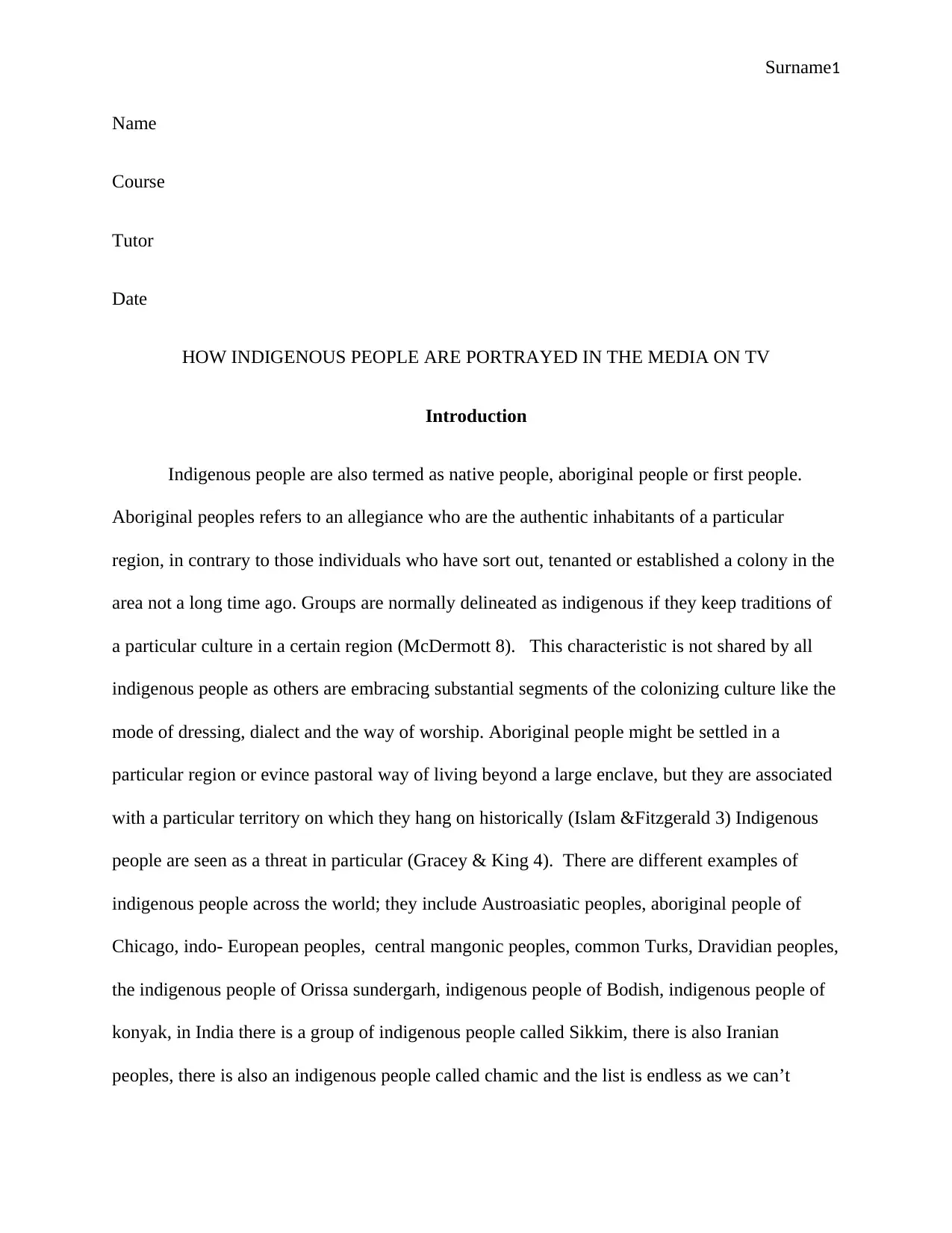
Surname1
Name
Course
Tutor
Date
HOW INDIGENOUS PEOPLE ARE PORTRAYED IN THE MEDIA ON TV
Introduction
Indigenous people are also termed as native people, aboriginal people or first people.
Aboriginal peoples refers to an allegiance who are the authentic inhabitants of a particular
region, in contrary to those individuals who have sort out, tenanted or established a colony in the
area not a long time ago. Groups are normally delineated as indigenous if they keep traditions of
a particular culture in a certain region (McDermott 8). This characteristic is not shared by all
indigenous people as others are embracing substantial segments of the colonizing culture like the
mode of dressing, dialect and the way of worship. Aboriginal people might be settled in a
particular region or evince pastoral way of living beyond a large enclave, but they are associated
with a particular territory on which they hang on historically (Islam &Fitzgerald 3) Indigenous
people are seen as a threat in particular (Gracey & King 4). There are different examples of
indigenous people across the world; they include Austroasiatic peoples, aboriginal people of
Chicago, indo- European peoples, central mangonic peoples, common Turks, Dravidian peoples,
the indigenous people of Orissa sundergarh, indigenous people of Bodish, indigenous people of
konyak, in India there is a group of indigenous people called Sikkim, there is also Iranian
peoples, there is also an indigenous people called chamic and the list is endless as we can’t
Name
Course
Tutor
Date
HOW INDIGENOUS PEOPLE ARE PORTRAYED IN THE MEDIA ON TV
Introduction
Indigenous people are also termed as native people, aboriginal people or first people.
Aboriginal peoples refers to an allegiance who are the authentic inhabitants of a particular
region, in contrary to those individuals who have sort out, tenanted or established a colony in the
area not a long time ago. Groups are normally delineated as indigenous if they keep traditions of
a particular culture in a certain region (McDermott 8). This characteristic is not shared by all
indigenous people as others are embracing substantial segments of the colonizing culture like the
mode of dressing, dialect and the way of worship. Aboriginal people might be settled in a
particular region or evince pastoral way of living beyond a large enclave, but they are associated
with a particular territory on which they hang on historically (Islam &Fitzgerald 3) Indigenous
people are seen as a threat in particular (Gracey & King 4). There are different examples of
indigenous people across the world; they include Austroasiatic peoples, aboriginal people of
Chicago, indo- European peoples, central mangonic peoples, common Turks, Dravidian peoples,
the indigenous people of Orissa sundergarh, indigenous people of Bodish, indigenous people of
konyak, in India there is a group of indigenous people called Sikkim, there is also Iranian
peoples, there is also an indigenous people called chamic and the list is endless as we can’t
Paraphrase This Document
Need a fresh take? Get an instant paraphrase of this document with our AI Paraphraser
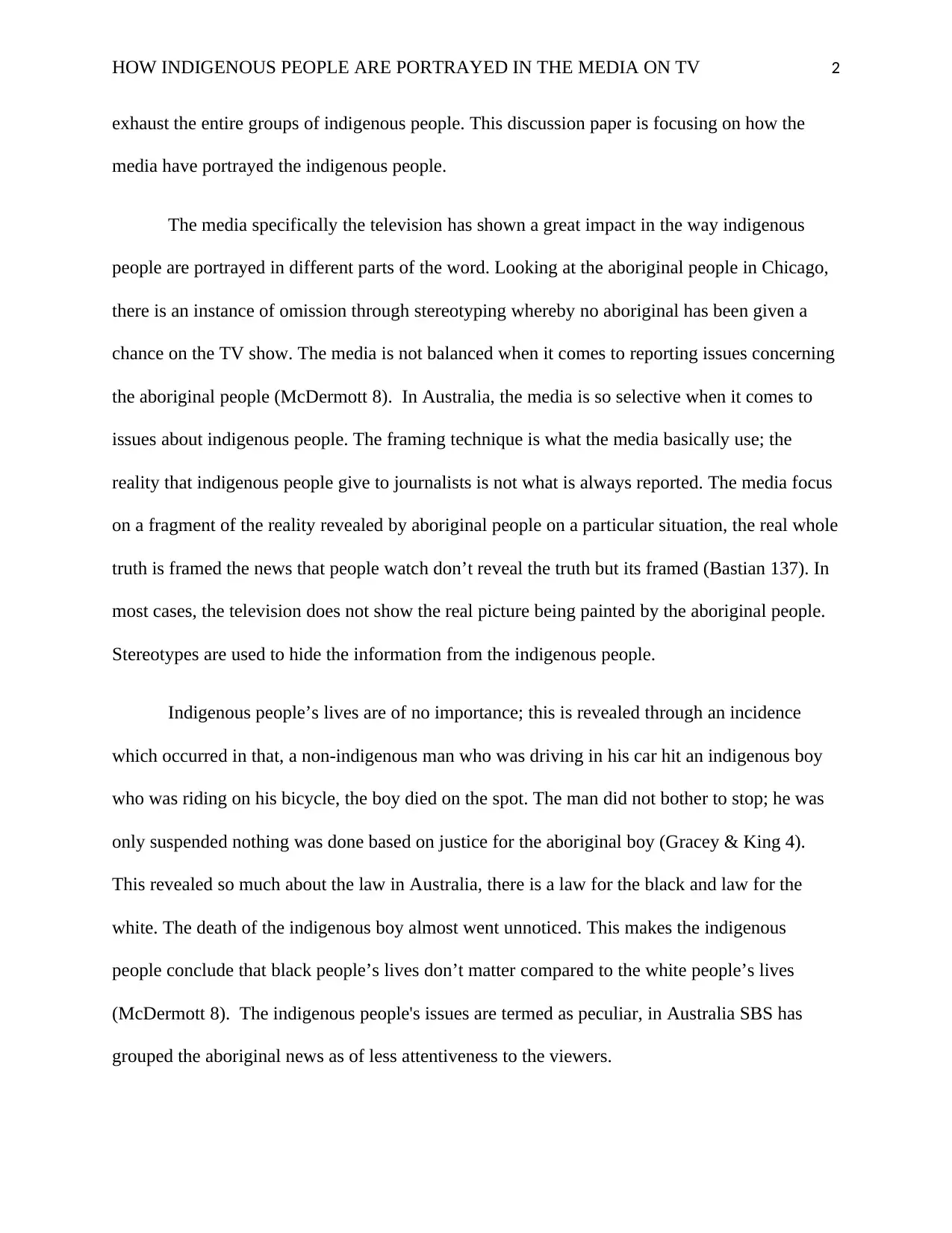
HOW INDIGENOUS PEOPLE ARE PORTRAYED IN THE MEDIA ON TV 2
exhaust the entire groups of indigenous people. This discussion paper is focusing on how the
media have portrayed the indigenous people.
The media specifically the television has shown a great impact in the way indigenous
people are portrayed in different parts of the word. Looking at the aboriginal people in Chicago,
there is an instance of omission through stereotyping whereby no aboriginal has been given a
chance on the TV show. The media is not balanced when it comes to reporting issues concerning
the aboriginal people (McDermott 8). In Australia, the media is so selective when it comes to
issues about indigenous people. The framing technique is what the media basically use; the
reality that indigenous people give to journalists is not what is always reported. The media focus
on a fragment of the reality revealed by aboriginal people on a particular situation, the real whole
truth is framed the news that people watch don’t reveal the truth but its framed (Bastian 137). In
most cases, the television does not show the real picture being painted by the aboriginal people.
Stereotypes are used to hide the information from the indigenous people.
Indigenous people’s lives are of no importance; this is revealed through an incidence
which occurred in that, a non-indigenous man who was driving in his car hit an indigenous boy
who was riding on his bicycle, the boy died on the spot. The man did not bother to stop; he was
only suspended nothing was done based on justice for the aboriginal boy (Gracey & King 4).
This revealed so much about the law in Australia, there is a law for the black and law for the
white. The death of the indigenous boy almost went unnoticed. This makes the indigenous
people conclude that black people’s lives don’t matter compared to the white people’s lives
(McDermott 8). The indigenous people's issues are termed as peculiar, in Australia SBS has
grouped the aboriginal news as of less attentiveness to the viewers.
exhaust the entire groups of indigenous people. This discussion paper is focusing on how the
media have portrayed the indigenous people.
The media specifically the television has shown a great impact in the way indigenous
people are portrayed in different parts of the word. Looking at the aboriginal people in Chicago,
there is an instance of omission through stereotyping whereby no aboriginal has been given a
chance on the TV show. The media is not balanced when it comes to reporting issues concerning
the aboriginal people (McDermott 8). In Australia, the media is so selective when it comes to
issues about indigenous people. The framing technique is what the media basically use; the
reality that indigenous people give to journalists is not what is always reported. The media focus
on a fragment of the reality revealed by aboriginal people on a particular situation, the real whole
truth is framed the news that people watch don’t reveal the truth but its framed (Bastian 137). In
most cases, the television does not show the real picture being painted by the aboriginal people.
Stereotypes are used to hide the information from the indigenous people.
Indigenous people’s lives are of no importance; this is revealed through an incidence
which occurred in that, a non-indigenous man who was driving in his car hit an indigenous boy
who was riding on his bicycle, the boy died on the spot. The man did not bother to stop; he was
only suspended nothing was done based on justice for the aboriginal boy (Gracey & King 4).
This revealed so much about the law in Australia, there is a law for the black and law for the
white. The death of the indigenous boy almost went unnoticed. This makes the indigenous
people conclude that black people’s lives don’t matter compared to the white people’s lives
(McDermott 8). The indigenous people's issues are termed as peculiar, in Australia SBS has
grouped the aboriginal news as of less attentiveness to the viewers.
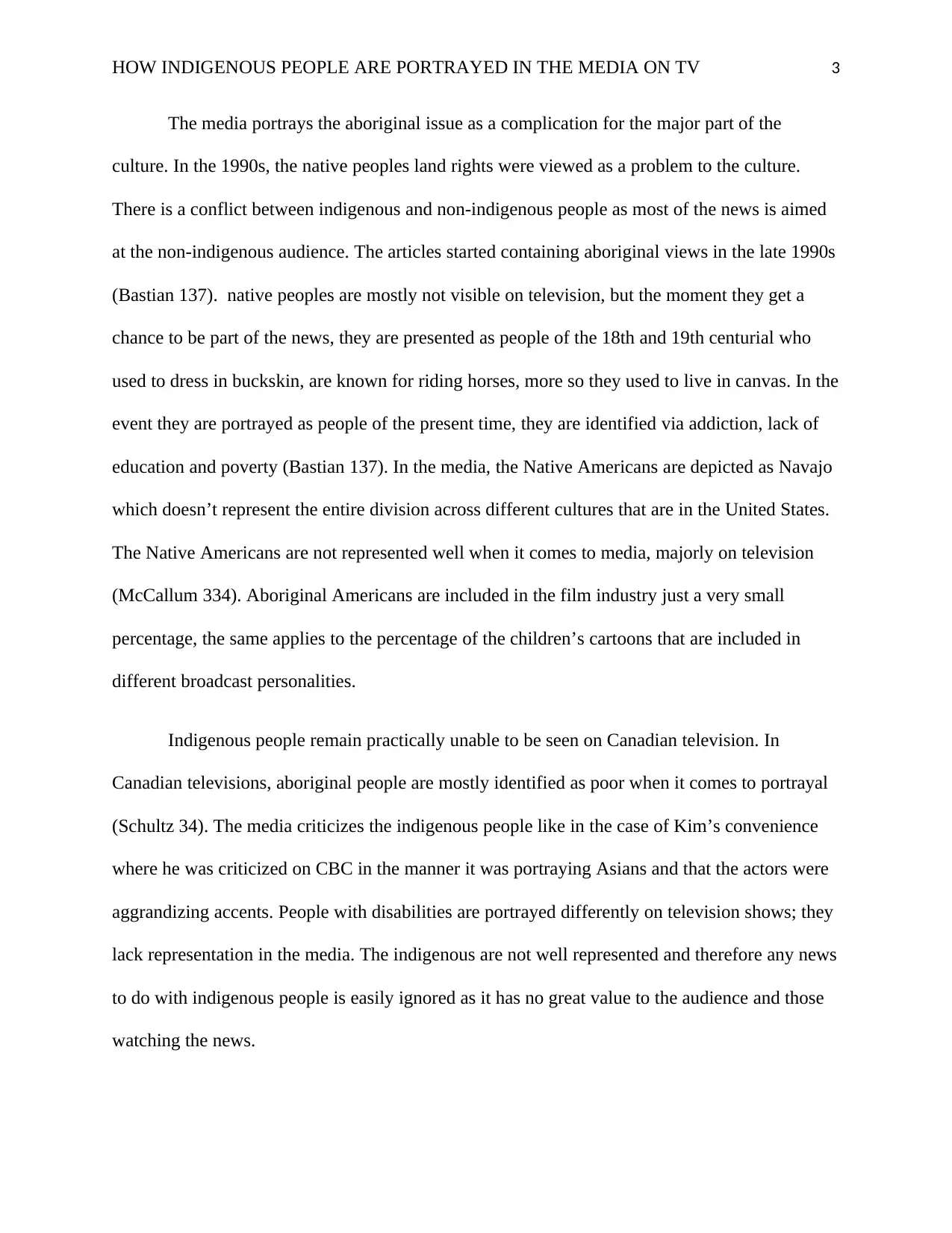
HOW INDIGENOUS PEOPLE ARE PORTRAYED IN THE MEDIA ON TV 3
The media portrays the aboriginal issue as a complication for the major part of the
culture. In the 1990s, the native peoples land rights were viewed as a problem to the culture.
There is a conflict between indigenous and non-indigenous people as most of the news is aimed
at the non-indigenous audience. The articles started containing aboriginal views in the late 1990s
(Bastian 137). native peoples are mostly not visible on television, but the moment they get a
chance to be part of the news, they are presented as people of the 18th and 19th centurial who
used to dress in buckskin, are known for riding horses, more so they used to live in canvas. In the
event they are portrayed as people of the present time, they are identified via addiction, lack of
education and poverty (Bastian 137). In the media, the Native Americans are depicted as Navajo
which doesn’t represent the entire division across different cultures that are in the United States.
The Native Americans are not represented well when it comes to media, majorly on television
(McCallum 334). Aboriginal Americans are included in the film industry just a very small
percentage, the same applies to the percentage of the children’s cartoons that are included in
different broadcast personalities.
Indigenous people remain practically unable to be seen on Canadian television. In
Canadian televisions, aboriginal people are mostly identified as poor when it comes to portrayal
(Schultz 34). The media criticizes the indigenous people like in the case of Kim’s convenience
where he was criticized on CBC in the manner it was portraying Asians and that the actors were
aggrandizing accents. People with disabilities are portrayed differently on television shows; they
lack representation in the media. The indigenous are not well represented and therefore any news
to do with indigenous people is easily ignored as it has no great value to the audience and those
watching the news.
The media portrays the aboriginal issue as a complication for the major part of the
culture. In the 1990s, the native peoples land rights were viewed as a problem to the culture.
There is a conflict between indigenous and non-indigenous people as most of the news is aimed
at the non-indigenous audience. The articles started containing aboriginal views in the late 1990s
(Bastian 137). native peoples are mostly not visible on television, but the moment they get a
chance to be part of the news, they are presented as people of the 18th and 19th centurial who
used to dress in buckskin, are known for riding horses, more so they used to live in canvas. In the
event they are portrayed as people of the present time, they are identified via addiction, lack of
education and poverty (Bastian 137). In the media, the Native Americans are depicted as Navajo
which doesn’t represent the entire division across different cultures that are in the United States.
The Native Americans are not represented well when it comes to media, majorly on television
(McCallum 334). Aboriginal Americans are included in the film industry just a very small
percentage, the same applies to the percentage of the children’s cartoons that are included in
different broadcast personalities.
Indigenous people remain practically unable to be seen on Canadian television. In
Canadian televisions, aboriginal people are mostly identified as poor when it comes to portrayal
(Schultz 34). The media criticizes the indigenous people like in the case of Kim’s convenience
where he was criticized on CBC in the manner it was portraying Asians and that the actors were
aggrandizing accents. People with disabilities are portrayed differently on television shows; they
lack representation in the media. The indigenous are not well represented and therefore any news
to do with indigenous people is easily ignored as it has no great value to the audience and those
watching the news.
⊘ This is a preview!⊘
Do you want full access?
Subscribe today to unlock all pages.

Trusted by 1+ million students worldwide
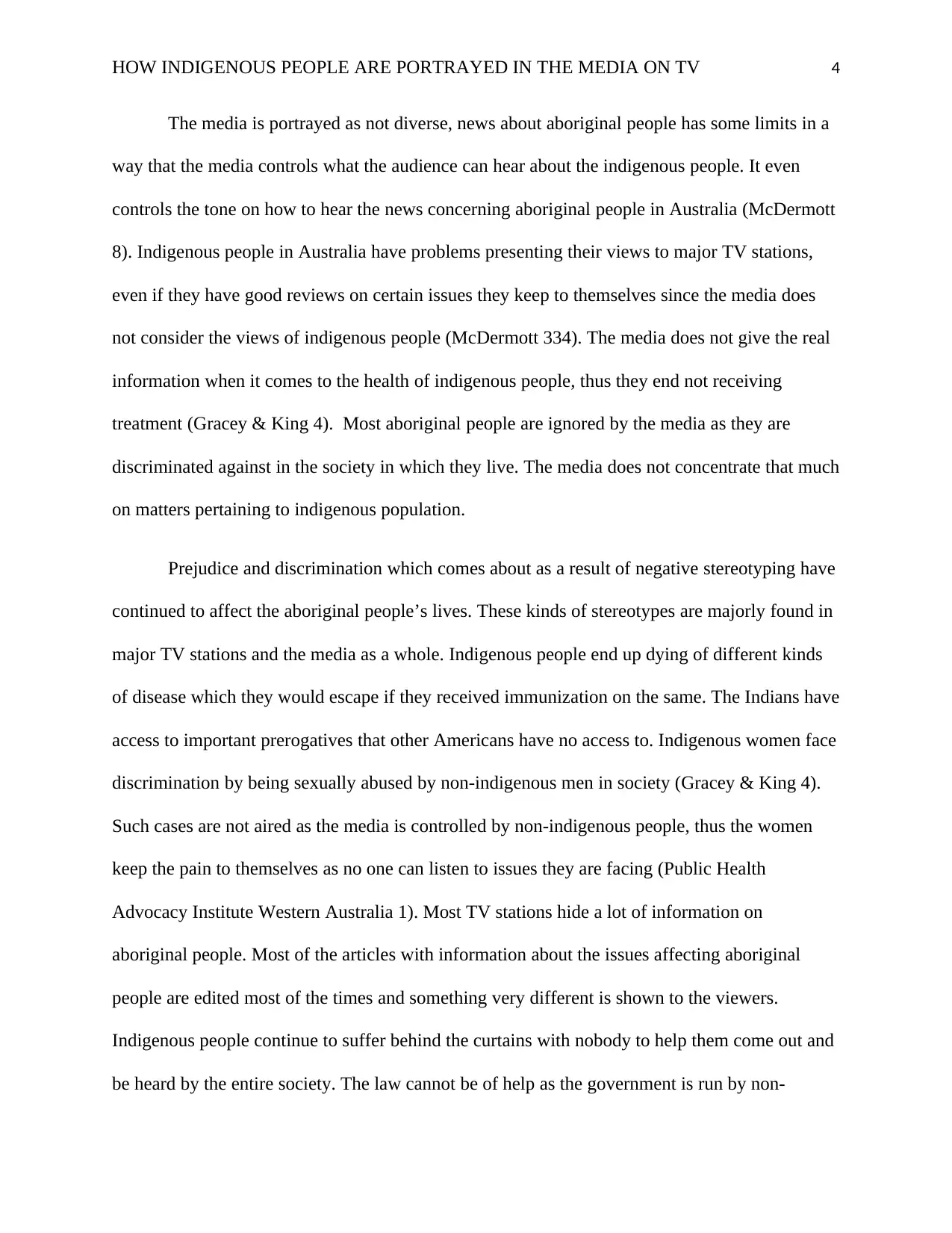
HOW INDIGENOUS PEOPLE ARE PORTRAYED IN THE MEDIA ON TV 4
The media is portrayed as not diverse, news about aboriginal people has some limits in a
way that the media controls what the audience can hear about the indigenous people. It even
controls the tone on how to hear the news concerning aboriginal people in Australia (McDermott
8). Indigenous people in Australia have problems presenting their views to major TV stations,
even if they have good reviews on certain issues they keep to themselves since the media does
not consider the views of indigenous people (McDermott 334). The media does not give the real
information when it comes to the health of indigenous people, thus they end not receiving
treatment (Gracey & King 4). Most aboriginal people are ignored by the media as they are
discriminated against in the society in which they live. The media does not concentrate that much
on matters pertaining to indigenous population.
Prejudice and discrimination which comes about as a result of negative stereotyping have
continued to affect the aboriginal people’s lives. These kinds of stereotypes are majorly found in
major TV stations and the media as a whole. Indigenous people end up dying of different kinds
of disease which they would escape if they received immunization on the same. The Indians have
access to important prerogatives that other Americans have no access to. Indigenous women face
discrimination by being sexually abused by non-indigenous men in society (Gracey & King 4).
Such cases are not aired as the media is controlled by non-indigenous people, thus the women
keep the pain to themselves as no one can listen to issues they are facing (Public Health
Advocacy Institute Western Australia 1). Most TV stations hide a lot of information on
aboriginal people. Most of the articles with information about the issues affecting aboriginal
people are edited most of the times and something very different is shown to the viewers.
Indigenous people continue to suffer behind the curtains with nobody to help them come out and
be heard by the entire society. The law cannot be of help as the government is run by non-
The media is portrayed as not diverse, news about aboriginal people has some limits in a
way that the media controls what the audience can hear about the indigenous people. It even
controls the tone on how to hear the news concerning aboriginal people in Australia (McDermott
8). Indigenous people in Australia have problems presenting their views to major TV stations,
even if they have good reviews on certain issues they keep to themselves since the media does
not consider the views of indigenous people (McDermott 334). The media does not give the real
information when it comes to the health of indigenous people, thus they end not receiving
treatment (Gracey & King 4). Most aboriginal people are ignored by the media as they are
discriminated against in the society in which they live. The media does not concentrate that much
on matters pertaining to indigenous population.
Prejudice and discrimination which comes about as a result of negative stereotyping have
continued to affect the aboriginal people’s lives. These kinds of stereotypes are majorly found in
major TV stations and the media as a whole. Indigenous people end up dying of different kinds
of disease which they would escape if they received immunization on the same. The Indians have
access to important prerogatives that other Americans have no access to. Indigenous women face
discrimination by being sexually abused by non-indigenous men in society (Gracey & King 4).
Such cases are not aired as the media is controlled by non-indigenous people, thus the women
keep the pain to themselves as no one can listen to issues they are facing (Public Health
Advocacy Institute Western Australia 1). Most TV stations hide a lot of information on
aboriginal people. Most of the articles with information about the issues affecting aboriginal
people are edited most of the times and something very different is shown to the viewers.
Indigenous people continue to suffer behind the curtains with nobody to help them come out and
be heard by the entire society. The law cannot be of help as the government is run by non-
Paraphrase This Document
Need a fresh take? Get an instant paraphrase of this document with our AI Paraphraser
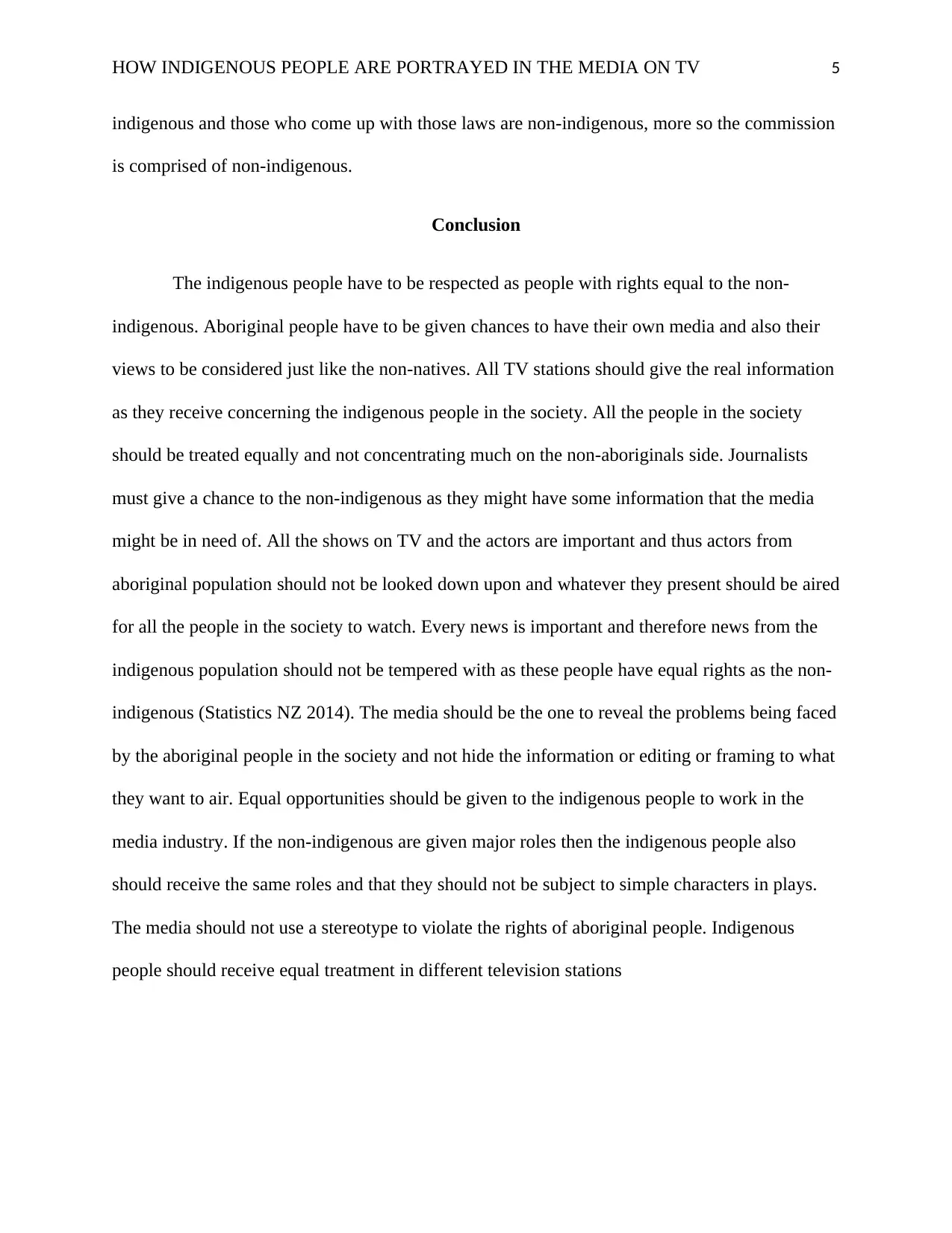
HOW INDIGENOUS PEOPLE ARE PORTRAYED IN THE MEDIA ON TV 5
indigenous and those who come up with those laws are non-indigenous, more so the commission
is comprised of non-indigenous.
Conclusion
The indigenous people have to be respected as people with rights equal to the non-
indigenous. Aboriginal people have to be given chances to have their own media and also their
views to be considered just like the non-natives. All TV stations should give the real information
as they receive concerning the indigenous people in the society. All the people in the society
should be treated equally and not concentrating much on the non-aboriginals side. Journalists
must give a chance to the non-indigenous as they might have some information that the media
might be in need of. All the shows on TV and the actors are important and thus actors from
aboriginal population should not be looked down upon and whatever they present should be aired
for all the people in the society to watch. Every news is important and therefore news from the
indigenous population should not be tempered with as these people have equal rights as the non-
indigenous (Statistics NZ 2014). The media should be the one to reveal the problems being faced
by the aboriginal people in the society and not hide the information or editing or framing to what
they want to air. Equal opportunities should be given to the indigenous people to work in the
media industry. If the non-indigenous are given major roles then the indigenous people also
should receive the same roles and that they should not be subject to simple characters in plays.
The media should not use a stereotype to violate the rights of aboriginal people. Indigenous
people should receive equal treatment in different television stations
indigenous and those who come up with those laws are non-indigenous, more so the commission
is comprised of non-indigenous.
Conclusion
The indigenous people have to be respected as people with rights equal to the non-
indigenous. Aboriginal people have to be given chances to have their own media and also their
views to be considered just like the non-natives. All TV stations should give the real information
as they receive concerning the indigenous people in the society. All the people in the society
should be treated equally and not concentrating much on the non-aboriginals side. Journalists
must give a chance to the non-indigenous as they might have some information that the media
might be in need of. All the shows on TV and the actors are important and thus actors from
aboriginal population should not be looked down upon and whatever they present should be aired
for all the people in the society to watch. Every news is important and therefore news from the
indigenous population should not be tempered with as these people have equal rights as the non-
indigenous (Statistics NZ 2014). The media should be the one to reveal the problems being faced
by the aboriginal people in the society and not hide the information or editing or framing to what
they want to air. Equal opportunities should be given to the indigenous people to work in the
media industry. If the non-indigenous are given major roles then the indigenous people also
should receive the same roles and that they should not be subject to simple characters in plays.
The media should not use a stereotype to violate the rights of aboriginal people. Indigenous
people should receive equal treatment in different television stations
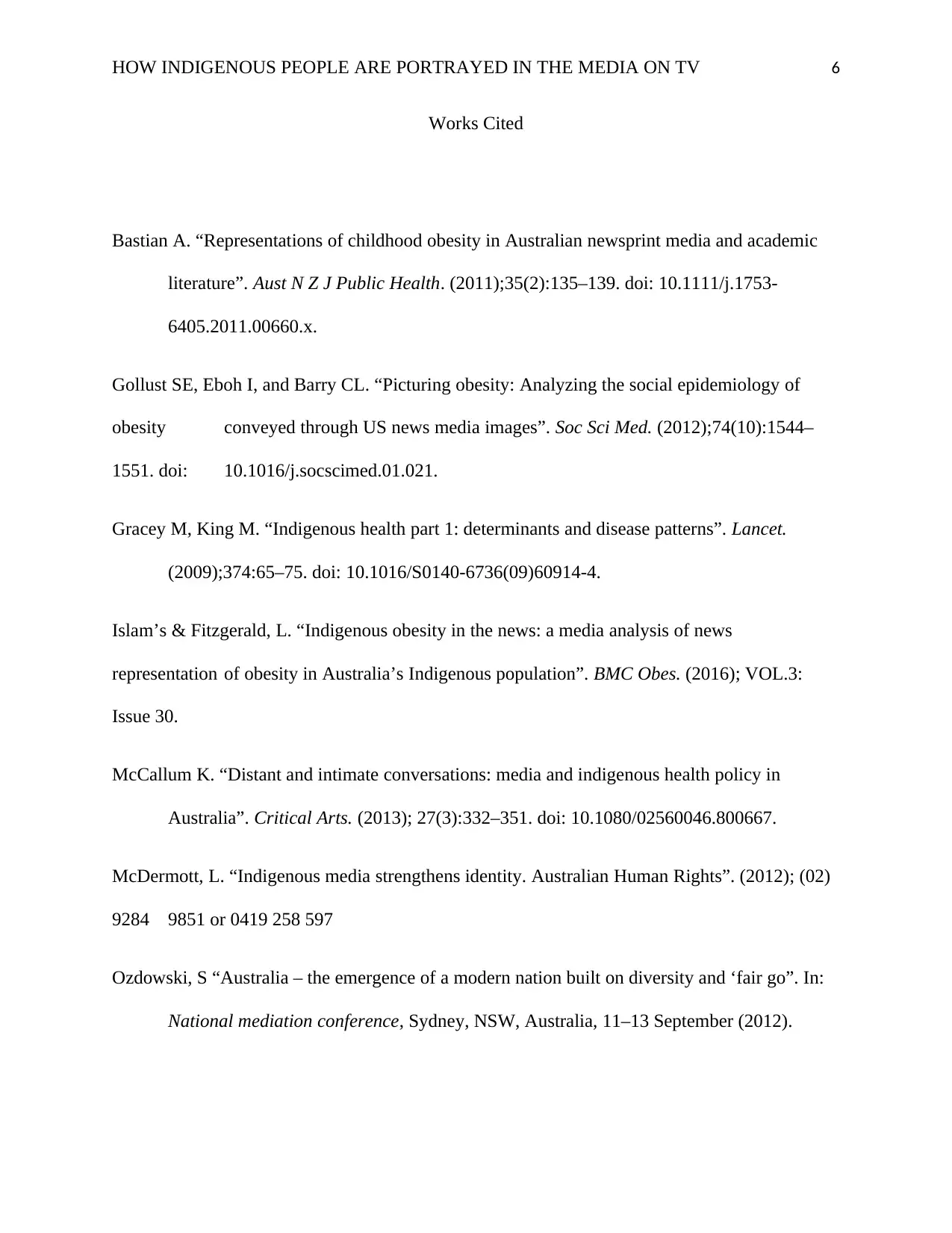
HOW INDIGENOUS PEOPLE ARE PORTRAYED IN THE MEDIA ON TV 6
Works Cited
Bastian A. “Representations of childhood obesity in Australian newsprint media and academic
literature”. Aust N Z J Public Health. (2011);35(2):135–139. doi: 10.1111/j.1753-
6405.2011.00660.x.
Gollust SE, Eboh I, and Barry CL. “Picturing obesity: Analyzing the social epidemiology of
obesity conveyed through US news media images”. Soc Sci Med. (2012);74(10):1544–
1551. doi: 10.1016/j.socscimed.01.021.
Gracey M, King M. “Indigenous health part 1: determinants and disease patterns”. Lancet.
(2009);374:65–75. doi: 10.1016/S0140-6736(09)60914-4.
Islam’s & Fitzgerald, L. “Indigenous obesity in the news: a media analysis of news
representation of obesity in Australia’s Indigenous population”. BMC Obes. (2016); VOL.3:
Issue 30.
McCallum K. “Distant and intimate conversations: media and indigenous health policy in
Australia”. Critical Arts. (2013); 27(3):332–351. doi: 10.1080/02560046.800667.
McDermott, L. “Indigenous media strengthens identity. Australian Human Rights”. (2012); (02)
9284 9851 or 0419 258 597
Ozdowski, S “Australia – the emergence of a modern nation built on diversity and ‘fair go”. In:
National mediation conference, Sydney, NSW, Australia, 11–13 September (2012).
Works Cited
Bastian A. “Representations of childhood obesity in Australian newsprint media and academic
literature”. Aust N Z J Public Health. (2011);35(2):135–139. doi: 10.1111/j.1753-
6405.2011.00660.x.
Gollust SE, Eboh I, and Barry CL. “Picturing obesity: Analyzing the social epidemiology of
obesity conveyed through US news media images”. Soc Sci Med. (2012);74(10):1544–
1551. doi: 10.1016/j.socscimed.01.021.
Gracey M, King M. “Indigenous health part 1: determinants and disease patterns”. Lancet.
(2009);374:65–75. doi: 10.1016/S0140-6736(09)60914-4.
Islam’s & Fitzgerald, L. “Indigenous obesity in the news: a media analysis of news
representation of obesity in Australia’s Indigenous population”. BMC Obes. (2016); VOL.3:
Issue 30.
McCallum K. “Distant and intimate conversations: media and indigenous health policy in
Australia”. Critical Arts. (2013); 27(3):332–351. doi: 10.1080/02560046.800667.
McDermott, L. “Indigenous media strengthens identity. Australian Human Rights”. (2012); (02)
9284 9851 or 0419 258 597
Ozdowski, S “Australia – the emergence of a modern nation built on diversity and ‘fair go”. In:
National mediation conference, Sydney, NSW, Australia, 11–13 September (2012).
⊘ This is a preview!⊘
Do you want full access?
Subscribe today to unlock all pages.

Trusted by 1+ million students worldwide
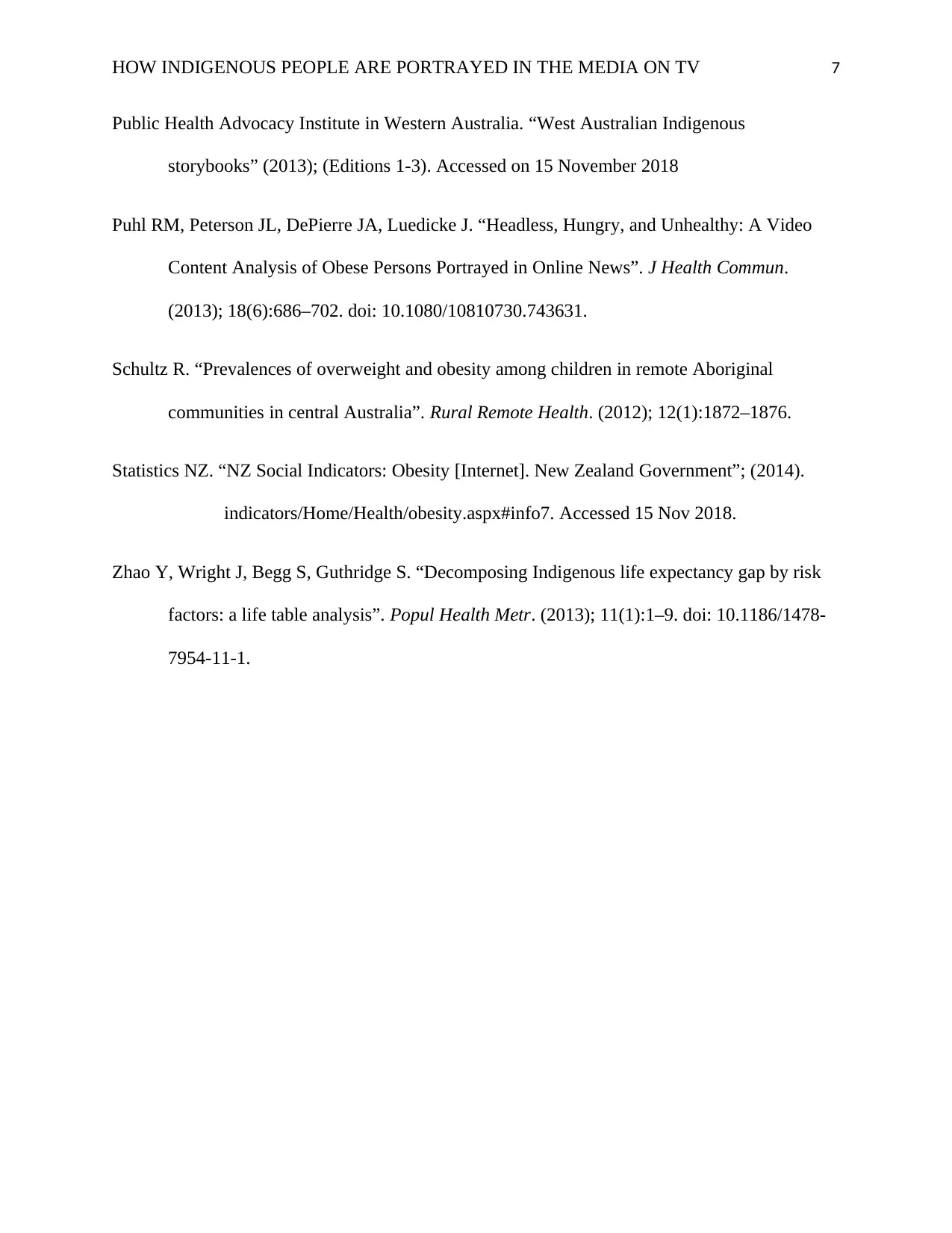
HOW INDIGENOUS PEOPLE ARE PORTRAYED IN THE MEDIA ON TV 7
Public Health Advocacy Institute in Western Australia. “West Australian Indigenous
storybooks” (2013); (Editions 1-3). Accessed on 15 November 2018
Puhl RM, Peterson JL, DePierre JA, Luedicke J. “Headless, Hungry, and Unhealthy: A Video
Content Analysis of Obese Persons Portrayed in Online News”. J Health Commun.
(2013); 18(6):686–702. doi: 10.1080/10810730.743631.
Schultz R. “Prevalences of overweight and obesity among children in remote Aboriginal
communities in central Australia”. Rural Remote Health. (2012); 12(1):1872–1876.
Statistics NZ. “NZ Social Indicators: Obesity [Internet]. New Zealand Government”; (2014).
indicators/Home/Health/obesity.aspx#info7. Accessed 15 Nov 2018.
Zhao Y, Wright J, Begg S, Guthridge S. “Decomposing Indigenous life expectancy gap by risk
factors: a life table analysis”. Popul Health Metr. (2013); 11(1):1–9. doi: 10.1186/1478-
7954-11-1.
Public Health Advocacy Institute in Western Australia. “West Australian Indigenous
storybooks” (2013); (Editions 1-3). Accessed on 15 November 2018
Puhl RM, Peterson JL, DePierre JA, Luedicke J. “Headless, Hungry, and Unhealthy: A Video
Content Analysis of Obese Persons Portrayed in Online News”. J Health Commun.
(2013); 18(6):686–702. doi: 10.1080/10810730.743631.
Schultz R. “Prevalences of overweight and obesity among children in remote Aboriginal
communities in central Australia”. Rural Remote Health. (2012); 12(1):1872–1876.
Statistics NZ. “NZ Social Indicators: Obesity [Internet]. New Zealand Government”; (2014).
indicators/Home/Health/obesity.aspx#info7. Accessed 15 Nov 2018.
Zhao Y, Wright J, Begg S, Guthridge S. “Decomposing Indigenous life expectancy gap by risk
factors: a life table analysis”. Popul Health Metr. (2013); 11(1):1–9. doi: 10.1186/1478-
7954-11-1.
1 out of 7
Related Documents
Your All-in-One AI-Powered Toolkit for Academic Success.
+13062052269
info@desklib.com
Available 24*7 on WhatsApp / Email
![[object Object]](/_next/static/media/star-bottom.7253800d.svg)
Unlock your academic potential
Copyright © 2020–2025 A2Z Services. All Rights Reserved. Developed and managed by ZUCOL.



